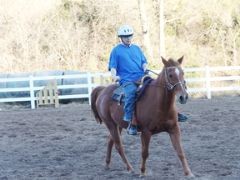FORT RILEY, Kan. - Equine therapy makes the difference for a Warrior Transition Battalion member and his daughter. Spc. Kevin Snow, an Iraq war veteran of the WTB, and Jazmin, his 8-year-old daughter, look forward to Wednesdays as the day they spend together with the horses. Snow and Jazmin participate in equine therapy at the Hope Ranch Therapeutic Riding Center in Manhattan, Kan.
The program offers equine facilitated therapeutic horsemanship and equine facilitated learning. The interactive experiences involving the horses and trainers promote emotional healing, build confidence, improve social skills and help clients heal in a positive, self-paced manner. The farm environment also provides a plethora of tasks to improve balance, equilibrium and motor skill refinement.
Snow and Jazmin have been participating in the program for more than a month and Snow said the benefits have been tremendous.
"I feel calmer after spending time with the horses and Jazmin and I are both in good moods when we leave the Hope Ranch," Snow said.
Snow, who had almost no experience with horses, works under the supervision of a trainer who observes as Snow catches, grooms and tacks up his horse. Snow spends about an hour riding his horse, "Red," at varying gaits through a variety of obstacles. Then, Snow is responsible to groom and bathe "Red" before he is turned back out to the pasture.
"When I come to Hope, I control a thousand-pound horse," Snow said. "That gives me a strong dose of self confidence in keeping control of my daily tasks."
"Since Kevin (Snow) started, I have watched his confidence and communication skills improve," said Cassey Dougherty, Hope Ranch trainer.
Fellow trainer Chelsea Nunn said that not everyone comes to Hope Ranch to ride. "Some people benefit from the exposure and feel of being around the horses, and we respect their right to have power over the pace of their therapy," Nunn said.
Horsemanship requires a lot of hand and eye coordination and also helps improve short term memory. Many tasks, such as tying a cinch or putting on a bridle, are repetitive and if done right, the horse will usually let you know, Dougherty added.
Jazmin also benefits from the exposure she receives while interacting with the farm kittens, dogs, miniature donkeys and the horses. Jazmin rides at an age-appropriate level with a trainer leading her horse. She performs simple exercises and is responsible for some grooming and a lot of touching and talking to the animals.
Ken Scroggs, Hope Ranch founder and director, has seen miraculous things happen to people at the ranch. Scruggs told of a child with multiple sclerosis with little lower body control who developed trunk control from riding and is now able to grip the saddle with her legs, and lift herself out of the seat. He also told of an expressionless, autistic child who began to smile and tried to speak after participating in equine therapy.
"When I researched equine therapy, I read of extraordinary accomplishments of handicapped people and was just elated when I began to see it happening here," Scruggs said.
The Hope Ranch has been in the Manhattan area for several years, and Scruggs is expanding services with the addition of a 100'x 200', indoor riding facility. Trainers at Hope Ranch are in varying phases of communication science and occupational therapy study programs. The trainers put the horses through testing and certification through a program with the North American Riding for the Handicapped Association.


Social Sharing